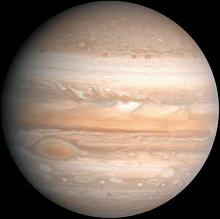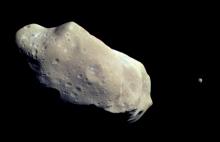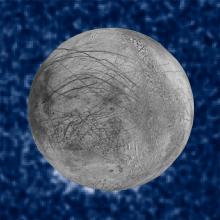You are here
Jupiter

As the Great Red Spot demonstrates, Jupiter is a world of superlatives. It is the largest planet in the solar system (big enough to swallow more than 1,300 Earths, and bigger than some types of stars), and more massive than the solar system's other known planets and moons combined. It rotates faster than any other planet, it produces the most powerful magnetic field, and it offers the largest and most interesting assortment of moons.
Despite its great size and its brightness in Earth's night sky, however, much about Jupiter remains poorly understood. Scientists must infer quite a bit about it from observations by the spacecraft that have visited the planet.
Much of the mystery surrounds Jupiter's interior. From the planet's mass, density, and magnetic field, scientists surmise that it probably has a dense core at least 10 times as massive as Earth. Observations by the orbiting Juno spacecraft, however, suggest that the core is "melty" -- perhaps solid in the middle, but more viscous at the perimeter.
A thick layer of hydrogen surrounds the core. Jupiter's gravity squeezes this layer so tightly that it acts as a metal. The metallic hydrogen probably rotates at a different speed from the core, so it produces a "dynamo" effect, generating electric currents that create Jupiter's magnetic field.
Layers of hydrogen and helium gas surround the metallic hydrogen, and a relatively thin layer of clouds envelops the entire planet. (This layer is actually hundreds of miles thick, but compared to Jupiter's great size, that's like the skin on an onion.) Jupiter's rapid rotation stretches the clouds into narrow bands that circle the entire planet.
The bands show different colors, which means their clouds are made of different materials and hover at different altitudes. The highest layers of clouds, which are white, are made of frozen ammonia. Clouds in the next layer contain ammonia mixed with other chemicals, so they look brown or orange. The lowest layers contain water vapor and water ice, so they look blue.
These bands form alternating light and dark stripes. The light-colored stripes are decks of clouds that are pushed high into the atmosphere by rising bubbles of warm gas. The darker stripes consist of cooler material that is dropping back into the planet's atmosphere.
Much of the weather in these zones draws its energy not from the Sun, as is the case with storms on Earth, but from deep within Jupiter itself. As Jupiter's gravity squeezes the planet, it produces heat that wells up through the atmosphere then escapes into space as infrared energy. Jupiter radiates more energy into space than it receives from the Sun.
Rings encircle Jupiter, although they are far darker and skimpier than those of the flashier planet Saturn. The rings may consist of material that was "sandblasted" off the surfaces of Jupiter's moons by collisions with meteorites.
Since Jupiter has no solid surface, no human will ever walk on the planet. In fact, any attempt to visit the Jovian system will require heavy shielding. Jupiter's magnetic field captures electrically charged particles from the Sun and from the planet's volcanic moon Io. These particles create strong radiation belts. Around Io's orbit, the radiation belts are powerful enough to kill an unprotected human in a few minutes. That adds one more item to the list of Jupiter's superlatives: deadliest radiation belts.
Viewing Guide
♃ Gas giant Jupiter starts the year off in the constellation Pisces, moves over to Cetus (the Whale), moves back over to Pisces, and eventually crosses into Aries where it stays for the remainder of the year. Jupiter's slivery-white brilliance will be especially enjoyable from October 11 - November 23 when it is at its brightest!
Exploration
Pioneer 10 and 11 blazed the trail to the outer solar system during the 1970s. Pioneer 10 became the first spacecraft to visit any planet beyond the asteroid belt when it flew past Jupiter on December 3, 1973. Pioneer 10 found that Jupiter's interior is hotter than previously thought, discovered that the planet's radiation belts are strong enough to kill a human being, and discovered that Jupiter's moon Io is embedded in a giant cloud of hydrogen that encircles Jupiter. Pioneer 11 flew past Jupiter a year later, then in 1979 became the first craft to encounter Saturn. Since then, several other spacecraft have flown past the giant planet, including Cassini, which used Jupiter's gravity to sling it out to Saturn. The Galileo spacecraft orbited Jupiter and its moons for more than five years. Juno has been orbiting Jupiter since 2016, mapping its magnetic and gravitational fields as probes of the planet's interior. Both the United States and Europe and planning to launch missions to study Jupiter's icy moons.
Keywords
At a Glance
| Discovery |
| Known since antiquity |
| Name |
| King of the Roman gods |
| Average Distance from Sun |
| 483,682,810 miles 778,412,020 km 5.2 Astronomical Units |
| Mass |
| 318 times Earth's mass |
| Equatorial Diameter |
| 88,846 miles 142,984 km |
| Length of Day |
| 9 hours, 56 minutes |
| Length of Year |
| 11.9 Earth years |
| Surface Gravity |
| 2.14 that of Earth (If you weigh 100 pounds, you would weigh about 214 pounds on Jupiter.) |
| Known Moons |
| 79 as of June 2021; Largest: Io, Europa, Ganymede, Callisto |
Teacher Copies
Request a free copy of The Solar System or Beyond the Solar System for your classroom. Bulk copies are available for $1.50 each in quantities of 30 or more. Shipping is included. Call 512-471-5285 for orders of 30 or more.
 The Astro Guides for the Solar System and Beyond the Solar System are supported by the National Aeronautics and Space Administration under Grant Nos. NNG04G131G and NAG5-13147, respectively.
The Astro Guides for the Solar System and Beyond the Solar System are supported by the National Aeronautics and Space Administration under Grant Nos. NNG04G131G and NAG5-13147, respectively.






